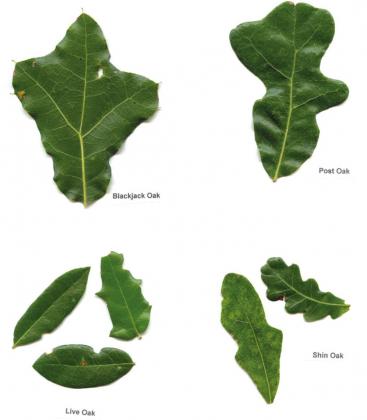The Other Common Oaks in the Hill Country
I have previously written about our Hill Country live oak because it is the most common oak around here and because it is often considered a symbol of the Hill Country. But there are several other oaks commonly found in our area that are interesting and important as well.
Oaks are classified as either white oaks or red oaks—the colors don’t mean much. There are two red oaks that grow natively in the Hill Country, Spanish oaks or Texas red oaks (two common names for the same species), (Quercus buckleyi) and blackjack oaks (Quercus marilandica). Red oaks can be identified by having leaves with the margins making sharp or moderately sharp points and with hair-like projections called bristles sticking out from each leaf point. White oak leaves have rounded lobes.
Spanish oaks are large to medium-sized trees with bark that frequently has whitish patches. The leaves tend to have several sharp points. They are the first oaks to green up in the spring, and at that time large hillsides can be seen with a very light green color that stands out from the dark green juniper. In the fall, in favorable years, Spanish oaks turn red and show more fall color than most of the other oaks. These trees tend to be somewhat brittle, and it is not uncommon for limbs to break off in windstorms.
Spanish oaks are deer favorites, and because of this, very few replacement Spanish oaks can be found on most properties in the Hill Country. This means that the population of Spanish oaks is declining and will surely continue to do so as long as the deer population remains as high as it is now. Spanish oaks make up an important part of the favorite habitat for golden cheeked-warblers.
Blackjack oaks are medium-sized trees, usually with very dark bark. Their leaves have rather broad points in a shape often described as a duck’s webbed foot. Their leaves are rather smooth on both sides; the top being darker green and shiny, the bottom lighter green and dull. These trees are also fairly early to leaf out in the spring. Like all other red oaks, their acorns take two years to mature.
Post oaks (Quercus stellata), a white oak, are often found growing along with blackjack oaks, especially in what are classified as upland/redland soils. Post oaks tend to have light-colored trunks that are frequently quite straight and tall (like a post). It is considered a very strong tree. The leaves have broad crossshaped lobes and are slightly rough both on top and bottom.
Shin oaks, white shin oaks or Bigelow oaks (Quercus sinuate) are small trees, with flaking, peeling bark. People sometimes refer to these trees as scrub oaks, but this is a common name applied to all sorts of small oaks so is meaningless as a common name for any species. Typically they grow in groups of two to four trees close together with trunks no greater than about six inches in diameter and usually less than 18 feet tall, although larger individuals are seen. They are prolific root sprouters and not deer favorites, so in areas of moderate deer populations it is common to find small root sprouts around the base of the trees. By winter, however, these sprouts are usually eaten.
The two red oaks, Spanish oaks and blackjack oaks, are susceptible to oak wilt, but generally, unlike live oaks, only individual trees get the fungus and do not transmit it to adjacent trees. So the loss of any given Spanish oak or blackjack oak from oak wilt is very unlikely. Post oaks and shin oaks virtually never die from oak wilt. Another disease, hypoxylon, can infect any stressed tree.
Blackjack oaks are difficult to transplant or grow from acorns, so they are almost never found in nurseries. Post oaks and shin oaks are difficult to find as well. Spanish oaks can usually be found in nurseries and can be grown from acorns as well.
Given the loss of all of these trees by age attrition and not being replaced because of deer, goats and exotics, all are, or soon will be, declining in population. So, protecting any natural root sprouts from the browsers with cages of wire or brush is important to maintain the population of these great trees.
Two other less-common Hill Country white oaks are Lacey oaks, Bur oaks and chinquapin oaks.
The chinquapin oak, which can be large trees frequently grow near water, Bur oaks with the largest leaves and acorns, but which are more common north an east of our area, and Lacey oaks, also called blue oaks, which are common in Kerr and surrounding counties.
Until next time…
Jim Stanley is a Texas Master Naturalist and the author of the books “Hill Country Ecology,” “Hill Country Landowner’s Guide” and “A Beginner’s Handbook for Rural Texas Landowners.” He can be reached at <jstmn@ktc.com>. Previous columns can be seen at >www.hillcountrynaturalist.org>.


